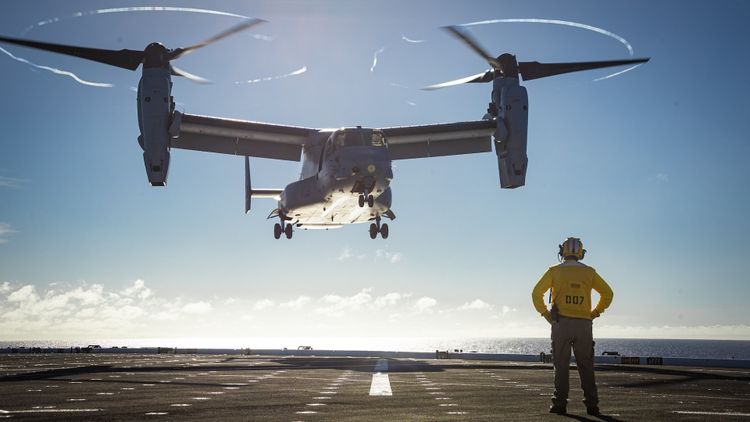PACIFIC OCEAN –
The Lewis B. Puller-class expeditionary mobile base USS John L. Canley (ESB 6) set sail through the Pacific Ocean with the Hawaiian island chain visible on the horizon. From October 4 to 21, 2024, Marine Aviation Logistics Squadron (MALS) 24, Marine Aircraft Group 24, 1st Marine Aircraft Wing led exercise Warrior Voyage. This exercise aimed to evaluate the ESB’s role in supporting intermediate-level (I-level) aviation logistics (AVLOG) and executing rapid refueling operations, both critical for maintaining the readiness of the Aviation Combat Element in the Indo-Pacific region.
The John L. Canley is a versatile mobile platform capable of supporting a wide range of military operations. These ships are built to commercial standards while integrating key Navy requirements, allowing them to operate effectively in a variety of environments. Measuring 785 feet long, with a 164-foot beam and a draft of 40 feet, the ESB can carry a displacement of 90,000 tons. It is designed for a speed of up to 15 knots and can travel 9,500 nautical miles, enabling sustained operations far from shore.
One of the defining features of the ESB is its operational flexibility. The ship is capable of supporting a range of missions, including airborne mine countermeasures, special operations and humanitarian assistance. Its design enables it to serve as a vital link between larger vessels and smaller landing craft, a critical capability where traditional shore-based infrastructure is either inaccessible or inadequate. This flexibility is especially significant in the Indo-Pacific region, where complex geographic conditions often pose logistical challenges.
The ESB is equipped with a large flight deck capable of supporting a variety of aircraft, including V-22 tiltrotor, H-53, H-60, and H-1 helicopters. Below the flight deck, the ship features a mission deck that allows for the staging of troops, equipment and supplies. This makes the ESB an ideal platform for conducting Expeditionary Advanced Base Operations and Distributed Aviation Operations, both of which are increasingly relevant in modern military strategy.
Exercise Warrior Voyage involved several key goals: providing effective maintenance support, utilizing Mobile Maintenance Facilities to enhance operational flexibility, evaluating the compatibility of ship power with these facilities, and conducting rigorous flight deck operations to ensure crew proficiency.
“There were multiple successes while aboard, such as successfully powering a MMF utilizing ship’s power, establishing, and maintaining a Marine Corps Enterprise Network, and the full integration of Marine Wing Support Squadron (MWSS) 174 Marines with the ESB’s fuel and firefighting divisions,” said Capt. Jeffery Johnson, the Avionics Department Head with MALS-24. “After the success of Warrior Voyage, I would recommend employing a larger footprint of MALS maintenance capabilities.”
During the exercise, the crew engaged in diverse training scenarios designed to assess the ESB’s operational capabilities. Training scenarios enabled the ESB crew to experiment with innovative concepts for I-level AVLOG support and evaluated the operational constraints to mission while aboard a ship. Throughout this process, the crew identified critical modifications necessary for establishing the ESB as the preferred afloat AVLOG platform.
“MALS-24, MWSS-174, and Marine Wing Communications Squadron 18 Marines and Sailors integrated into the ship’s life with ease,” explained Staff Sgt. Avery James, the Mobile Facility Staff Noncommissioned Officer in Charge (SNCOIC) with MALS-24. “For a lot of the Marines and Sailors, it was their first experience being embarked aboard a ship.”
While aboard, the crew executed numerous operations on the flight deck, facilitating the launch and recovery of various aircraft. These operations were not only essential for maintaining aircraft readiness but also demonstrated the ESB's ability to meet diverse mission requirements. Completing these complex operations at sea showcased the adaptability and readiness of Marine forces in a rapidly changing security environment in the Indo-Pacific.
“It was a good opportunity for all the Marines and Sailors from Marine Corps Base Hawaii to spectate how an operation is conducted on a ship,” stated 1st Lt. Xavier Chiodo, the Aviation Supply Officer with MALS-24. “A few MWSS-174 Crash, Fire, and Rescue Marines were able to lend a hand to the ESB 6 sailors during the operations, making it go even smoother than expected.”
As the exercise progressed, Marines reflected on their experiences and the lessons learned. The training enabled by Warrior Voyage provided valuable insight into future requirements for aviation logistics support ships, advanced I-level forward AVLOG, and reinforced the ESB’s critical role as a strategic asset for Marine aviation readiness across the region.
“The ship’s crew were extremely professional and understanding on every level, so we would like to thank them for making the adjustment as smooth as it could be,” said Staff Sgt. Daniel Widdows, the Work Center SNCOIC with MALS-24.
“Overall, the Marines had a good time and got exposure not all their peers will be able to experience. After a few days, people were able to adjust to their new quarters, culture, and schedule,” continued Staff Sgt. Felipe Gonzalez, the Audit Branch SNCOIC with MALS-24.
As Warrior Voyage concluded and the John L. Canley returned to port, both MALS-24 and the ship’s crew parted ways with enhanced operational expertise, better prepared for future missions.


































